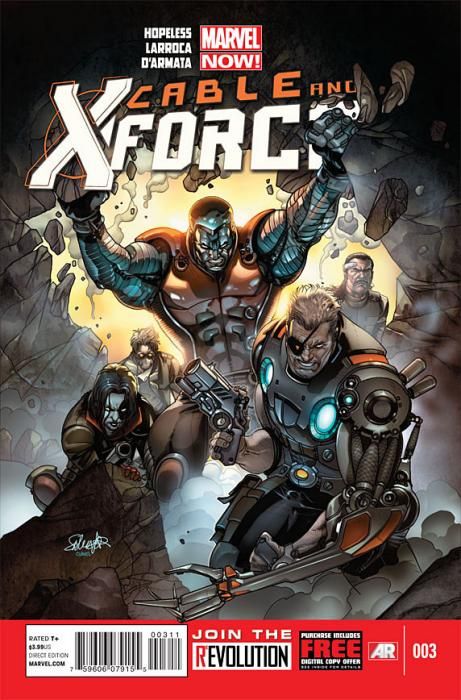In "Cable and X-Force" #3, Dennis Hopeless, Salvador Larroca and Frank D'Armara have Cable launch the team into its first real mission after all the members of the new X-Force have been assembled.
Dennis Hopeless' script shifts in time and place six times in only twenty pages of story. The good news is that each shift is clearly marked with a timestamp and also by Larroca and Frank D'Armara's artwork. With effort, the reader can follow what is going on. The bad news is that I'm not sure what the point is. Hopeless' choice to tell "Cable and X-Force" #3 in nonlinear, plotline-intersecting flashback instead of in a straight linear narrative doesn't serve enough storytelling purpose to justify its unnecessarily complicated approach.
On a deeper and larger level, Hopeless' plot is a simple one: precognition of disaster, reconnaissance and preemptive strike, with some classic family and soap opera dynamics like terminal illness and overprotective parenting in the mix.
A time or setting shift every few pages is inevitably disorienting, but that may be the intended effect. The spastic jumping around in time and setting reinforces the chaotic, post-apocalyptic mood that Hopeless is going for, and it also reminds the reader of Cable's powers.
However, Hopeless' flashy technique has a price, and all the temporal shifts leave little room for character development or emotional depth. None of Hopeless' dialogue works to give the reader a sense of all the players as people beyond superficial descriptions like "tough guy leader" or "pouty teenager." In a Marvel NOW! title only three issues in trying retain new readers, the lack of characterization in "Cable and X-Force" #3 is a serious drawback. In Hopeless' favor, his pacing feels right for his complex timeline, and he builds suspense slowly but effectively around primary epidemic-level threat.
"Cable and X-Force" #3 opens with a panel showing Hope asleep, her head towards the reader. It's very pretty in composition and coloring, especially the hair, and Larroca and D'Armara keep the shading and lighting consistent as the camera angle reverses in the next panel. Pencils are soft-edged and are filled with D'Armara's soft colors, which are executed in monotone from panel to panel, varying between light neon shades of blue, peach-orange, green, desert yellow. D'Armata's unusual technique in "Cable and X-Force" #3 is pretty and moody, but it also puts a barrier between the reader and the characters, because it's like being under disco lights for the entire issue, with everything bathed in the same hue and character's faces often lit from single bulbs overhead.
Although his panels are well-composed, Larroca's action scenes seem frozen and his facial expressions. The result is a series of images in "Cable and X-Force" #3 that are visually pleasing as static frames, but don't convey much emotion or jazz up the flow of action -- two cornerstones to good visual storytelling.
"Cable and X-Force" #3 finally has its team of mutants united under one mission, and the plot is speeding up, but the writing and the art are both pushing more style than substance, and at $3.99 for twenty pages, the mild suspense created may not be enough to keep readers coming back.

